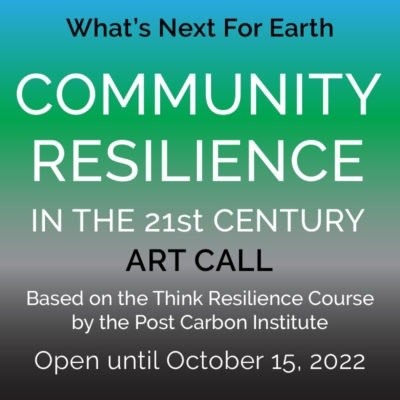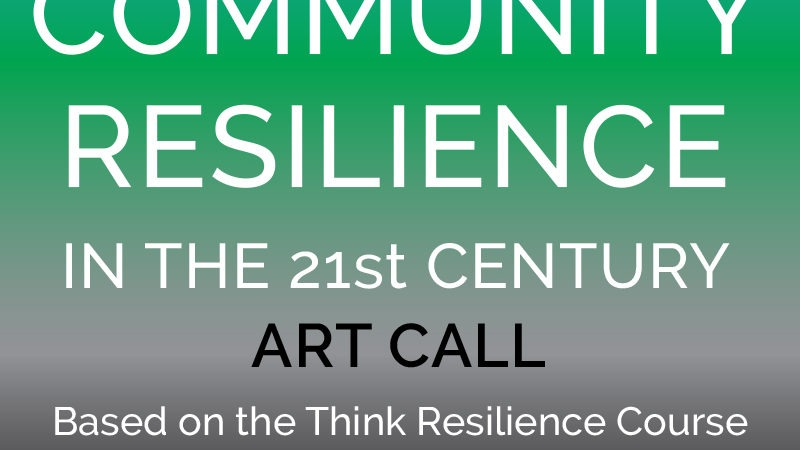
You are invited to participate in @WhatsNextForEarth’s art call Community Resilience in the 21st Century, open until October 15, 2022. What’s Next for Earth is a participative art project on Instagram that invites artists to respond to a bi-monthly topic, reflecting on the human predicament. An online exhibition will be on view on this website and on the MAHB website, in the arts section.
“In this video, we’re going to bring resilience, which we defined and discussed in the last video, into the context of this century’s simmering and complex “E4” crises, with (1) ecological, (2) energy, (3) economic, and (4) equity dimensions. We’ll clarify the relationship between sustainability and resilience, and show why a lot of the climate change resilience discussion—while necessary—doesn’t go far enough. And we’ll explain why this video series focuses primarily on building resilience at the community level, as opposed to the global, national, or household level.“
– Richard Heinberg
How to Participate
1. Please make an artwork in response to the Post Carbon Institute free online course – lesson 14.
The best is to watch all the lessons before this one to get an overview of the Human Predicament. Each video is related to the previous one. Sign up for the THINK RESILIENCE COURSE if you did not do it before. If you do not have the time, PLEASE READ THE VIDEO TRANSCRIPT of the “Community Resilience in the 21st Century” lesson.
Here are the previous lessons:
CHAPTER ONE – Our converging Crisis
– Energy, (lesson 2)
– Population and Consumption (lesson 3)
– Depletion (lesson 4)
– Pollution (Lesson 5)
CHAPTER TWO – The Roots and Results of Our Crises
– Political & Economic Management (Social Structure) (lesson 6)
– Belief Systems (lesson 7)
– Biodiversity (lesson 8)
– Collapse (lesson 9)
CHAPTER THREE – Making Change
In this session, we’ll learn how change happens and how we might influence change in human society:- Thinking in Systems (lesson 10)
– Shifting Cultural Stories (lesson 11)
– Culture Change and Neuroscience (lesson 12)
CHAPTER FOUR – Resilience Thinking
– What is Resilience? (lesson 13)
– Community Resilience in the 21st Century (lesson 14)
2. Create your piece using any format/technique you wish.
3. Post it on your Instagram page. Include a description of your piece in your photo’s caption: title, technique, size, and, most importantly, the relationship with the theme.
Please do not forget to copy and paste all these tags at the end of your description – select the whole list (from top to bottom), copy and paste in your post, right after the descrition of your piece:
#communityresilience #artcall
@WhatsNextForEarth
@mahbglobal
@postcarboninstitute
#extractionart
#mahbstanfordarts
#WhatsNextForEarth
#ecoart
#artactivism
#humanpredicament
#mahbartscommunity
#anthropocene
#climateemergency
#climatechange
#codered
#UprootTheSystem
#EndFossilFuels
#TellTheTruth
#BlahBlahBlah
About the Think Resilience Course
"Acting without this understanding is like putting a bandage on a life-threatening injury."
Think Resilience is hosted by Richard Heinberg, one of the world’s leading experts on the urgency and challenges of moving society away from fossil fuels.

We live in a time of tremendous political, environmental, and economic upheaval. What should we do?
Think Resilience is an online course offered by Post Carbon Institute to help you get started on doing something. It features twenty-two video lectures—about four hours total—by Richard Heinberg, one of the world’s foremost experts on the urgency and challenges of transitioning society away from fossil fuels. Think Resilience is rooted in Post Carbon Institute’s years of work in energy literacy and community resilience. It packs a lot of information into four hours, and by the end of the course you’ll have good start on two important skills:
1. How to make sense of the complex challenges society now faces. What are the underlying, systemic forces at play? What brought us to this place? Acting without this understanding is like putting a bandage on a life-threatening injury.
2. How to build community resilience. While we must also act in our individual lives and as national and global citizens, building the resilience of our communities is an essential response to the 21st century’s multiple sustainability crises.
How to participate in the Art Call
1. Sign up for the THINK RESILIENCE COURSE if you did not do it before. If possible, watch all the videos, and watch “What is Resilience?”. If you do not have the time, PLEASE READ THE VIDEO TRANSCRIPT.
2. Create your piece using any format/technique you wish.
3. Post it on your Instagram page. Include a description of your piece in your photo’s caption: title, technique, size, and, most importantly, the relationship with the theme.
Copy and paste all these tags at the end of your description (#WhatsNextForEarth is very important to include because it is the hashtag used to find the posts participating in the art call on Instagram):
#whatisresilience #artcall
@WhatsNextForEarth
@mahbglobal
@postcarboninstitute
#extractionart
#mahbstanfordarts
#WhatsNextForEarth
#ecoart
#artactivism
#humanpredicament
#mahbartscommunity
#anthropocene
#anthropoceneart
#climateemergency
#climatechange
#codered
#TellTheTruth
#EndFossilFuels
#BlaBlaBlah
What’s Next For Earth is an art project created by Michele Guieu, eco-artist, and MAHB Arts Coordinator, to reflect on the climate emergency, the human predicament and envision a desirable future. The project is supported by the MAHB. If you have any questions, please send a message to michele@mahbonline.org.
Thank you ~

